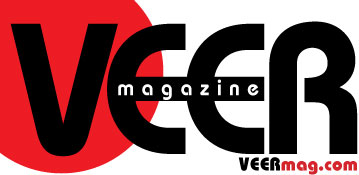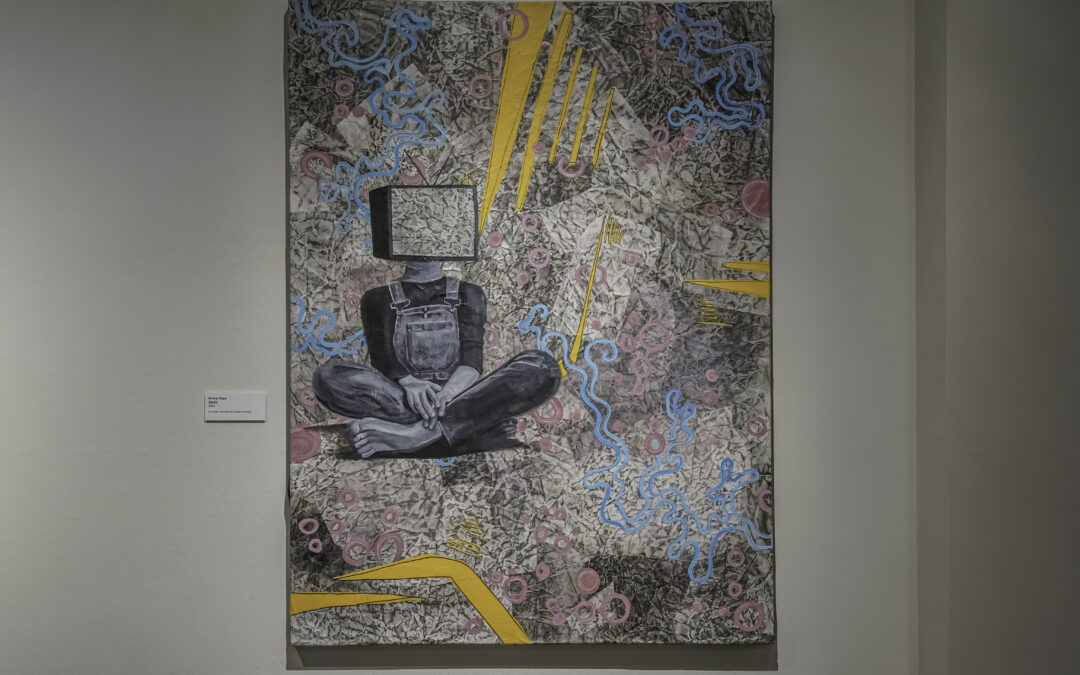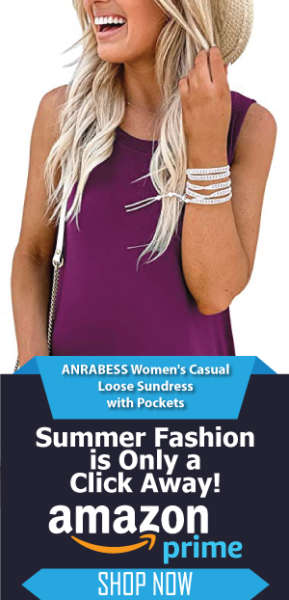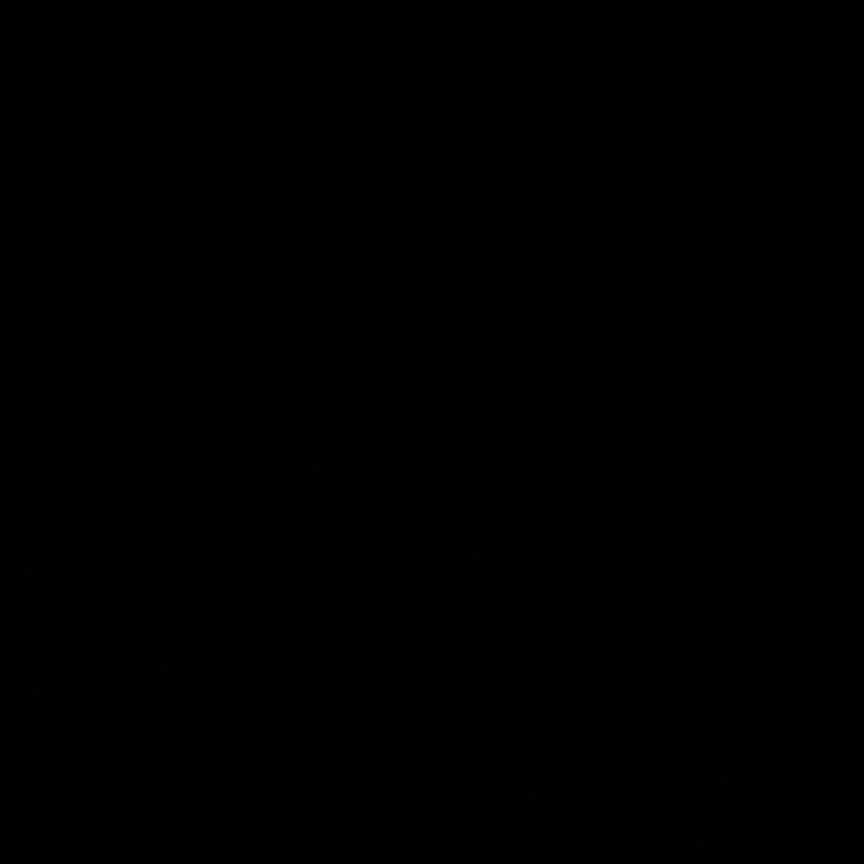(Avery Keys’ Static )
By Betsy DiJulio
“Is it my imagination or is ODU student work considerably stronger than in the past?” I asked John Roth, professor and chair of the ODU art department, via messenger, pressing further, “If the latter, to what do you attribute it?” He responded, “This last show was maybe the strongest in the 18 years I’ve been here. Thanks for paying attention…We have improved standards, and we have many new/energetic faculty.” I’ll say.
But neither my question nor his answer was meant to disparage former students or faculty because institutions evolve with the present building on the foundation of the past. Those who come after stand on the shoulders of those who came before. In this case, the evidence lay in a generally and consistently higher level of ambition, technique, craftsmanship, maturity, and professionalism.
Helping to throw this leveling up into high relief was Gayle Paul’s astute jurying of the exhibition. The low-key, high-powered curator at the Portsmouth Art & Cultural Center, Paul winnowed down 84 entries by 19 artists to 50 through an online portal, selecting Best in Show in person. Earning that honor was Megan Obenaus’s sculpture entitled Wash, Rinse, Repeat. Beautifully crafted and a complete thought, especially in terms of its presentation, the piece is essentially a shower “back brush” suspended from a wittily familiar home improvement store-style hook in front of a neutral mosaic tiled backdrop. Oddly arresting, the absurdist “brush” features brown hair seemingly growing out of a waxy soap-like “flesh-colored” substrate on one side while, on the opposite, the “soap” appears carved into an inverted nose, complete with piercing.
In a short Instagram video, the artist spoke about the piece in terms of a sense of control, from cutting one’s hair to body modification. About her selection, Paul wrote to me, “This work spoke to me on a subliminal level. It was whimsical yet presented a puzzle much like the work of (surrealist) Meret Oppenheim, Breakfast in Fur, 1936. And, like the fur-lined teacup…There is an edge to the work in the way that the everyday objects are juxtaposed to change their meaning.”
Other best-in-shows to my eye include Avery Keys’ Static, a large oil, acrylic, and charcoal collage on canvas. What appears to be pieces of wrinkled charcoal frottage (rubbings)—but are, in fact, very smooth—create the ground for a coverall-clad figure painted in grisaille sitting cross-legged with a computer-like box for a head. On the screen is more of the frottage “static.” Surrounding the figure are abstract lines and shapes in pastel blue, pink, and vibrant yellow.
Taken together, the images seems to suggest that the meaningless, incomprehensible noise that surrounds us fills our heads with nonsense.
When Zentangle grows up, it wants to be what Bryce Ross creates with graphite and ink pens. In It Breathes, this young artist creates lines so delicate, dense, and fine it is as though ants’ feet were dipped in ink before turning them loose in a flash mob. The choreographed, calligraphic line in red and black metamorphose into a pair of maze-like lungs connected to a dense field above. Both are not only animated across the surface but appear to fold and undulate like origami and fabric, respectively.
Mariposa Estrada’s Koi Curiosity is a bird’s eye view graphite drawing of three whimsical wide-eyed fish, expertly composed, with additive shading so velvety and subtractive highlighting so delicate as to boggle the mind.
Bria Tyler’s Mane Chandelier, crafted of black and red synthetic braids and wire on a chandelier form, calls to mind the work of Sonya Clark who uses fiber, including human hair, to explore issues of race, class, culture, and history. Here, long black braids, punctuated with large clear glass beads, are suspended from a traditional chandelier with flame-tip bulbs nestled in flower forms fashioned from more braids dyed red. In style, the chandelier is very Colonial, calling to mind issues parallel to Clark’s.
As an upper school art teacher, I have joked with my students that if I ever see a skeleton in art again, it will be too soon, so if they incorporate a skeleton, it better be the most innovative use of bones I’ve ever seen. It is as though Morgan Mackay Staples overheard my admonition for Floral Tears, while it may not be the most innovative skeleton I have yet to see, is expertly painted in acrylic with the most beautiful color harmony. Evocative of nostalgic floral wallpaper in the background, the muted pinks, yellows, and blues are more vibrant in the foreground depiction of an open-mouthed skeleton holding flowers whose petals are cascading, fountain-like. The handling of this modified primary color palette is strong, but not too, like neon with an attitude adjustment.
Audrey Redford was clearly paying attention in pastel class. Her handling of the medium in a trio of landscapes like Sand Dunes, Backbay, is flawless. The deliciously neutralized palette, contrast, and confident blending of strokes is dazzling in an understated way. Though the subjects are in no way compelling or thought-provoking, the technique is so superb that I almost don’t care.
Michael Suriano’s digital illustration entitled Rocket City Blues is why poster art dares call itself art. Its color palette of terracotta, pink, gold, sage green, black, and white is as sophisticated as the imagery with its modified mid-century vibe. Concentric lines radiate out from a humanoid trophy-like rocket blasting skyward over a solarized urban landscape, its horizon low. Functioning almost as data visualization, the simple text reads, from bottom to top, “CEO to Worker Pay Ratio, 20:1, 1965 / 61:1, 1989 / 399:1, 2023.
Kathryn Wolliver proves herself to be at least as high achieving of a poet as she is an artist. In the wall-mounted pages of what appears to be a deconstructed book of writing and digitally scanned blue India Ink drawings of her cat created in InDesign, she writes so sensitively and knowingly about the deep attachment between people and the animals they are privileged to care for. The last two pages read:
And you were with me in my in-betweens
In between girl and woman
Crush and heartbreak
Night and dawn, you curled between my side and arm
I kissed in between your eyes
On your little silver face.
I’ll never forget how I laid with you
At your in-between of life and death
And I felt the warmth between your body and my palm
For the last time
Now there is a hole in between my heart
And my stomach.
WANT TO SEE?
2024 ODU Juried Student Exhibition
Through April 6
Gordon Art Galleries, Old Dominion University
757.683.6271




